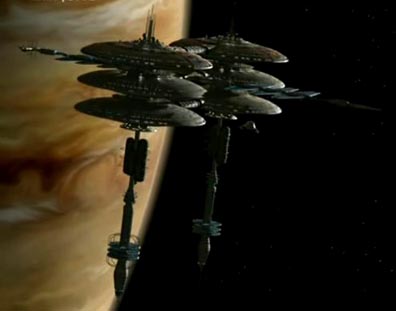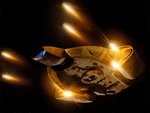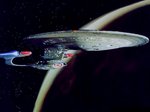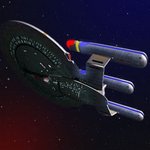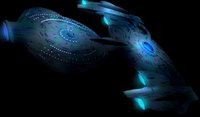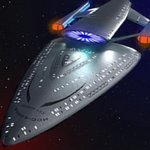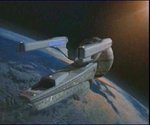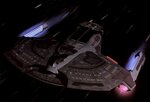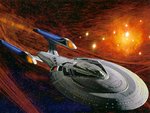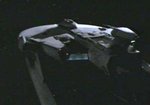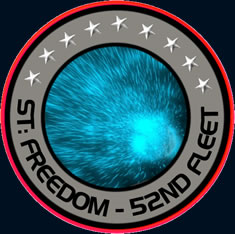Federation Starships: Difference between revisions
(Reverting to last revision not containing links to *.com) |
|||
| (17 intermediate revisions by 3 users not shown) | |||
| Line 1: | Line 1: | ||
[[image:jupsta.jpg |400px|right|]] | [[image:jupsta.jpg |400px|right|]] | ||
==Federation Starship Classes and Technical Readouts:== | |||
==Technical Readouts:== | |||
== | ==[[image:akiracl.jpg |150px|left|]] [[Akira Class:]]== | ||
With six new vessels being turned out a year since 2355, the pride of the Fleet is the Akira Class Heavy Cruiser. New vessels off the line sport a forty attack craft in its through deck hangar as well as fifteen torpedo tubes, making the Akira Class the most lethal fighting vessel ever to serve in the Federation, more so than even the Prometheus Class Tactical Assault Cruiser and the new Defiant Class Escort vessels. Fast, maneuverable, and sturdy, sixteen of these ships alone were lost to the Dominion War. Presently, one hundred and five are serving throughout Federation Space, and no end is presently scheduled in the production life of the Akira Class. | |||
==[[image:ambcl.jpg |150px|right|]] [[Ambassador Class:]]== | |||
==[[image:ambcl.jpg |150px|right|]] [[Ambassador Class]]== | |||
The Ambassador Class series began construction in 2315, fifteen years before the Excelsior Class contract expired. They were originally intended to replace the Excelsior as the foremost Explorer Type vessel. Forty two vessels were built as Explorers, including the flagship USS Enterprise-C. However, when the First Cardassian War broke out in 2347, the Class was reclassified as a Heavy Cruiser, equipped with additional tactical systems, and structurally upgraded to counter the Cardassian Threat with eighteen ships built to the new specifications. At the end of the recent Dominion War, forty-nine Ambassador Class starships are still on operational status. | The Ambassador Class series began construction in 2315, fifteen years before the Excelsior Class contract expired. They were originally intended to replace the Excelsior as the foremost Explorer Type vessel. Forty two vessels were built as Explorers, including the flagship USS Enterprise-C. However, when the First Cardassian War broke out in 2347, the Class was reclassified as a Heavy Cruiser, equipped with additional tactical systems, and structurally upgraded to counter the Cardassian Threat with eighteen ships built to the new specifications. At the end of the recent Dominion War, forty-nine Ambassador Class starships are still on operational status. | ||
==[[image:conscl.jpg |150px|left|]] [[Constellation Class:]]== | |||
==[[image:conscl.jpg |150px|left|]] [[Constellation Class]]== | |||
The Constellation class was fielded during the 2280's as a modern counterpart to the Constitution class. Like the Constitution Class, the Constellation's requirements, issued in 2272, called for a vessel capable of long duration exploratory, scientific and diplomatic missions. The new ship was to be able to perform this role over the longer ranges called for now that the Federation had acquired new members beyond its previous borders. In addition, the Constellations combat capability was to put it ahead of any current or projected vessels in the Romulan and Klingon Empires. | The Constellation class was fielded during the 2280's as a modern counterpart to the Constitution class. Like the Constitution Class, the Constellation's requirements, issued in 2272, called for a vessel capable of long duration exploratory, scientific and diplomatic missions. The new ship was to be able to perform this role over the longer ranges called for now that the Federation had acquired new members beyond its previous borders. In addition, the Constellations combat capability was to put it ahead of any current or projected vessels in the Romulan and Klingon Empires. | ||
| Line 53: | Line 35: | ||
A few Constellation class vessels remain in service today. | A few Constellation class vessels remain in service today. | ||
==[[image:concl.jpg |150px|right|]] [[Constitution Class]]== | ==[[image:concl.jpg |150px|right|]] [[Constitution Class:]]== | ||
In 2269, the USS Enterprise was selected to be the first ship to undergo such a refit and went into spacedock in Earth orbit for eighteen months of work. Never in Starfleet history (up until that time) had any vessel been so comprehensively updated, essentially a new vessel was built onto the bones of the old, replacing virtually every major system. The Enterprise was rushed out of Spacedock in 2271 to face the threat presented by the entity known as V'Ger, which was destroying everything in its path as it advanced towards Earth. She succeeded in averting the danger and then proceeded with her shakedown cruise. | In 2269, the USS Enterprise was selected to be the first ship to undergo such a refit and went into spacedock in Earth orbit for eighteen months of work. Never in Starfleet history (up until that time) had any vessel been so comprehensively updated, essentially a new vessel was built onto the bones of the old, replacing virtually every major system. The Enterprise was rushed out of Spacedock in 2271 to face the threat presented by the entity known as V'Ger, which was destroying everything in its path as it advanced towards Earth. She succeeded in averting the danger and then proceeded with her shakedown cruise. | ||
| Line 71: | Line 53: | ||
Two of the class were lost fighting the Borg, one at Wolf 359 and the other in Sector 001 a few years later. In 2335, four of the remaining eight Constitutions’ were mothballed while a second major refit of the class was designed. Of the other four, they were all active at the beginning of the Dominion war. Two are still in operation, including the class leader, the USS Constitution. | Two of the class were lost fighting the Borg, one at Wolf 359 and the other in Sector 001 a few years later. In 2335, four of the remaining eight Constitutions’ were mothballed while a second major refit of the class was designed. Of the other four, they were all active at the beginning of the Dominion war. Two are still in operation, including the class leader, the USS Constitution. | ||
==[[image:defcl.jpg |150px|left|]] [[Defiant Class]]== | ==[[image:defcl.jpg |150px|left|]] [[Defiant Class:]]== | ||
Classified as an escort, the Defiant project was unofficially a plan to build a fleet of Federation warships to combat the Borg. The Defiant proved to be a powerful design. In fact, it was so powerful, with its warp core at full power, it nearly blew itself apart. After the Borg threat lessened, the Defiant project was cancelled and the USS Defiant remained uncompleted. The Defiant project was restarted in 2371, after the success of the USS Defiant in defending Starbase Deep Space Nine. There are currently more Defiant-Class starships under construction. | |||
==[[image:excelcl.jpg |150px|right|]] [[Excelsior Class:]]== | |||
Originally dubbed the "Great Experiment," the Excelsior project was to be the first transwarp powered starship. Unfortunately, transwarp proved to be a failure and the ships were built with normal warp drives. A slightly modified Excelsior-Class has upgraded impulse, ramscoop and sensor technology. The Excelsior Class is one of the most successful Federation starship class, serving from 2287 to the present. | |||
==[[image:galcl.jpg |150px|left|]] [[Galaxy Class:]]== | |||
==[[image: | |||
One of the finest Starships ever designed the Galaxy class was to replace the Ambassador and Oberth-Class starships as the primary instrument of Federation exploration. The Galaxy-Class starship was the first to feature a saucer section which could separate at will and reattach itself without a starbase layover. The Galaxy-Class project was conducted at Utopia Planitia Shipyards, orbiting Mars. | One of the finest Starships ever designed the Galaxy class was to replace the Ambassador and Oberth-Class starships as the primary instrument of Federation exploration. The Galaxy-Class starship was the first to feature a saucer section which could separate at will and reattach itself without a starbase layover. The Galaxy-Class project was conducted at Utopia Planitia Shipyards, orbiting Mars. | ||
==[[image:champlainimage.jpg |150px|right|]] [[Galaxy Class Refit:]]== | |||
==[[image:champlainimage.jpg |150px| | |||
In the year 2369, Starfleet charged Utopia Planitia Shipyards and Avalon Shipyards to design and/or modify a vessel with both strong exploratory and defensive powers while the Sovereign project was still under development. Avalon began design and construction of what would later be called the Keltoi class of vessels, whereas Utopia Planitia built off of the existing Galaxy class Star frame. | In the year 2369, Starfleet charged Utopia Planitia Shipyards and Avalon Shipyards to design and/or modify a vessel with both strong exploratory and defensive powers while the Sovereign project was still under development. Avalon began design and construction of what would later be called the Keltoi class of vessels, whereas Utopia Planitia built off of the existing Galaxy class Star frame. | ||
The | The result was the Galaxy Class Dreadnaught, a refit version with an upgraded power source, one more warp nacelle for warp stability and serious upgrades to her weapons array. She has the same sensor capability as the standard Galaxy, but her weapons and defenses have nearly doubled in power and striking ability. | ||
==[[image:indef.jpg |150px|left|]] [[Indefatigable Class]]== | |||
The Indefatigable Class ship is a Tri-vector Assault vehicle, it separates into three fully-capable sections while in Vector-Assault mode. All three sections maintain power, supplies and crew for operations of up to 1 year in the event that the other sections are destroyed in combat, and all contain the necessary command functions (bridge, engineering, etc) to retain full autonomy. However, the Saucer Section does not possess Warp capability. | |||
==[[image:intrcl.jpg |150px|right|]] [[Intrepid Class:]]== | |||
==[[image:intrcl.jpg |150px| | |||
The Intrepid Class Starship is designed primarily as a science/scout ship. This class is designed with variable geometry warp nacelles, to eliminate damage to subspace while at warp. Beginning with the Voyager, the Intrepid line was the first to incorporate bio-neural technology into the computer systems. Intrepid-Class ships were also among to first to have and emergency medical holographic programs. | The Intrepid Class Starship is designed primarily as a science/scout ship. This class is designed with variable geometry warp nacelles, to eliminate damage to subspace while at warp. Beginning with the Voyager, the Intrepid line was the first to incorporate bio-neural technology into the computer systems. Intrepid-Class ships were also among to first to have and emergency medical holographic programs. | ||
==[[Image:Boudicca2.jpg |200px| | ==[[Image:Boudicca2.jpg |200px|left|]] [[Keltoi Class:]]== | ||
The Keltoi class is renowned for its reliability in combat; she is a departure for Starfleet in her design and layout. The USS Keltoi, the prototype of the class, spent several months on the Cardassian border. In a mission to defend a Federation subspace relay, the Captain of the Keltoi, held for several days against several waves of Cardassian ships. Severely damaged in her efforts, the Keltoi was decommissioned, and shortly after, the Keltoi development project was approved. | The Keltoi class is renowned for its reliability in combat; she is a departure for Starfleet in her design and layout. The USS Keltoi, the prototype of the class, spent several months on the Cardassian border. In a mission to defend a Federation subspace relay, the Captain of the Keltoi, held for several days against several waves of Cardassian ships. Severely damaged in her efforts, the Keltoi was decommissioned, and shortly after, the Keltoi development project was approved. | ||
==[[image:mercl.jpg |150px|right|]] [[Meredith Class:]]== | |||
==[[image:mercl.jpg |150px| | |||
The Meredith Class Starship was conceived to operate as a mobile command centre for Starfleet's top brass, able to lead assaults and act as a Fleet Carrier. This starship class has a formidable defensive capacity as well as firepower and fighter capabilities. | The Meredith Class Starship was conceived to operate as a mobile command centre for Starfleet's top brass, able to lead assaults and act as a Fleet Carrier. This starship class has a formidable defensive capacity as well as firepower and fighter capabilities. | ||
==[[image:mircl.jpg |150px| | ==[[image:mircl.jpg |150px|left|]] [[Miranda Class:]]== | ||
In the year 2273 a new class of ship entered service in Starfleet. Designed to be a smaller but capable counterpart to the Constitution class, the USS Miranda entered service at the same time its larger cousin was undoing major refit. There was a very high degree of commonality between the two classes, with the nacelles and most of the primary hull being almost identical. The smaller size of these ships was largely accounted for by a lower level of habitability for the crew and a reduction in the number of science labs from fourteen to ten. Moving all of its torpedo tubes to the 'roll bar' above the ship helped keep these reductions to a minimum. Even so the Miranda's were full Explorer type ships, fully capable of conducting long duration research missions. Their considerable armament also made them an important addition to the defense of the Federation. | In the year 2273 a new class of ship entered service in Starfleet. Designed to be a smaller but capable counterpart to the Constitution class, the USS Miranda entered service at the same time its larger cousin was undoing major refit. There was a very high degree of commonality between the two classes, with the nacelles and most of the primary hull being almost identical. The smaller size of these ships was largely accounted for by a lower level of habitability for the crew and a reduction in the number of science labs from fourteen to ten. Moving all of its torpedo tubes to the 'roll bar' above the ship helped keep these reductions to a minimum. Even so the Miranda's were full Explorer type ships, fully capable of conducting long duration research missions. Their considerable armament also made them an important addition to the defense of the Federation. | ||
| Line 163: | Line 97: | ||
Today the Miranda's operate in a similar capacity, and although they are not front-line combat units in themselves they are still to be seen operating in major fleet actions in support of the modern vessels. Recently several Miranda class vessels have begun to show signs of serious stress fractures in their hulls, investigations are underway with all ships in the class, and although the results are yet to be announced it is thought that the problem is likely due to the age of the hulls. If so, the Miranda class is likely to be forced into retirement sometime over the next few years. | Today the Miranda's operate in a similar capacity, and although they are not front-line combat units in themselves they are still to be seen operating in major fleet actions in support of the modern vessels. Recently several Miranda class vessels have begun to show signs of serious stress fractures in their hulls, investigations are underway with all ships in the class, and although the results are yet to be announced it is thought that the problem is likely due to the age of the hulls. If so, the Miranda class is likely to be forced into retirement sometime over the next few years. | ||
==[[image:neb.jpg |150px|right|]] [[Nebula Class:]]== | |||
==[[image:neb.jpg |150px| | |||
The Nebula Class was designed with an emphasis on flexibility. This is made possible by the raised equipment pod, which can be easily modified to carry scientific or tactical equipment pallets, or a combination of both configurations. Fifty three vessels were in service as of 2376, and an open ended construction contract is still on the table at the Utopia Yards. Though categorized as an Explorer, the Nebula Class can excel at virtually any task Operations can think of, from limited survey missions to deep strike missions into the Dominion Alliance. | The Nebula Class was designed with an emphasis on flexibility. This is made possible by the raised equipment pod, which can be easily modified to carry scientific or tactical equipment pallets, or a combination of both configurations. Fifty three vessels were in service as of 2376, and an open ended construction contract is still on the table at the Utopia Yards. Though categorized as an Explorer, the Nebula Class can excel at virtually any task Operations can think of, from limited survey missions to deep strike missions into the Dominion Alliance. | ||
==[[image:newocl.jpg |150px| | ==[[image:newocl.jpg |150px|left|]] [[New Orleans Class:]]== | ||
The New Orleans class has been the premier Starfleet frigate for nearly four decades. Sporting three outboard equipment modules, this vessel can be quickly and easily adapted to any scientific or military mission the Sector Command deems necessary. This class has the ability to incorporate a total of six torpedo tubes, which can be installed, one forward and one aft in each module. | The New Orleans class has been the premier Starfleet frigate for nearly four decades. Sporting three outboard equipment modules, this vessel can be quickly and easily adapted to any scientific or military mission the Sector Command deems necessary. This class has the ability to incorporate a total of six torpedo tubes, which can be installed, one forward and one aft in each module. | ||
| Line 175: | Line 107: | ||
A wide variety of sensor equipment can also, of course, be installed. One hundred fifty New Orleans class ships have been constructed over a thirty year period, and nearly a hundred of those are still in service. A number of these ships have played pivotal roles in Starfleet history, namely the Rutledge at Setlik III during the Second Cardassian War and also at the Battle of Archanis in 2373. The Kyushu was at Wolf 359 and the Peacekeeper during the Dominion War in 2375. | A wide variety of sensor equipment can also, of course, be installed. One hundred fifty New Orleans class ships have been constructed over a thirty year period, and nearly a hundred of those are still in service. A number of these ships have played pivotal roles in Starfleet history, namely the Rutledge at Setlik III during the Second Cardassian War and also at the Battle of Archanis in 2373. The Kyushu was at Wolf 359 and the Peacekeeper during the Dominion War in 2375. | ||
==[[image:norcl.jpg |150px| | ==[[image:norcl.jpg |150px|right|]] [[Norway Class:]]== | ||
By the 2350s the Miranda Class was beginning to show its age. In 2357, the Norway Class Development Project was tasked by Operations to produce a vessel with the endurance and flexibility the Miranda's had demonstrated. The Norway Class is now in full production at Spacedock 1's vast orbital construction yard, putting out 15 new vessels per year. As of 2376, there are 105 ships of this class, filling the multi-rolled niche retiring Miranda Class vessels are leaving behind. | By the 2350s the Miranda Class was beginning to show its age. In 2357, the Norway Class Development Project was tasked by Operations to produce a vessel with the endurance and flexibility the Miranda's had demonstrated. The Norway Class is now in full production at Spacedock 1's vast orbital construction yard, putting out 15 new vessels per year. As of 2376, there are 105 ships of this class, filling the multi-rolled niche retiring Miranda Class vessels are leaving behind. | ||
==[[image:novcl.jpg |150px| | ==[[image:novcl.jpg |150px|left|]] [[Nova Class:]]== | ||
This diminutive starship is part of a new family of Starfleet vessels. Aggressively designed, the small ship is known for its durability. The Nova Class is also slowly gaining a reputation for their usefulness in completing extremely successful missions to new areas of space, bringing back detailed data on individual systems or space anomalies to Starfleet. The Nova has a minimal weapons array for its size but its scientific capabilities make it a first rate explorer and science vessel. | This diminutive starship is part of a new family of Starfleet vessels. Aggressively designed, the small ship is known for its durability. The Nova Class is also slowly gaining a reputation for their usefulness in completing extremely successful missions to new areas of space, bringing back detailed data on individual systems or space anomalies to Starfleet. The Nova has a minimal weapons array for its size but its scientific capabilities make it a first rate explorer and science vessel. | ||
==[[image:obercl.jpg |150px| | ==[[image:obercl.jpg |150px|right|]] [[Oberth Class:]]== | ||
The Oberth class has had a distinguished Starfleet career dating back for over a century. They were a capable platform from which to conduct scientific research and exploration. Oberth's had some crucial advantages, they were easy to construct, maintain, and run. The design was highly modular, the whole vessel was made up of sections of 50, 150, or 300 tons which were simply bolted together, gamma welded, and sealed. | The Oberth class has had a distinguished Starfleet career dating back for over a century. They were a capable platform from which to conduct scientific research and exploration. Oberth's had some crucial advantages, they were easy to construct, maintain, and run. The design was highly modular, the whole vessel was made up of sections of 50, 150, or 300 tons which were simply bolted together, gamma welded, and sealed. | ||
| Line 197: | Line 129: | ||
In the 2340's all units received new Phaser banks and shielding systems. The Oberth class is now expected to remain in service at least until the beginning of this century. | In the 2340's all units received new Phaser banks and shielding systems. The Oberth class is now expected to remain in service at least until the beginning of this century. | ||
==[[image:olycl.jpg |150px| | ==[[image:olycl.jpg |150px|left|]] [[Olympic Class:]]== | ||
The Olympic class stems from a Starfleet requirement issued in 2360 for a new class of medical vessel to replace the aging McCoy class. The new ship was to be an improvement on the McCoy in every respect; it would incorporate a complete Starbase level mobile hospital capable of catering for up to 1,250 patients, compared to the McCoy’s 500. The warp and impulse drives, computer systems, etc. were also to be up to the latest standards. | The Olympic class stems from a Starfleet requirement issued in 2360 for a new class of medical vessel to replace the aging McCoy class. The new ship was to be an improvement on the McCoy in every respect; it would incorporate a complete Starbase level mobile hospital capable of catering for up to 1,250 patients, compared to the McCoy’s 500. The warp and impulse drives, computer systems, etc. were also to be up to the latest standards. | ||
| Line 205: | Line 137: | ||
The early careers of the Olympic Class were relatively uneventful, although the USS Olympic herself rescued several hundred survivors from the immediate aftermath of the battle against the Borg at Wolf 359. | The early careers of the Olympic Class were relatively uneventful, although the USS Olympic herself rescued several hundred survivors from the immediate aftermath of the battle against the Borg at Wolf 359. | ||
==[[image:promcl.jpg |150px| | ==[[image:promcl.jpg |150px|right|]] [[Prometheus Class:]]== | ||
This Starship is an experimental long range tactical starship which served as the testbed for the new Multi-Vectored Attack design. In MVA mode, the Prometheus separates into 3 warp-capable sections, each fully armed and attacks their target from multiple vectors. The MVA sequence is fully automated and computer controlled. The Prometheus also was the launch pad of the new EMH Mark II, an upgraded version of the EMH used on earlier starships and had holoemitters on each deck. | |||
==[[image:sabcl.jpg |150px|left|]] [[Saber Class:]]== | |||
==[[image:sabcl.jpg |150px|left]] [[Saber Class]]== | |||
The Saber Class is small, fast, nimble and heavily armed. Some in Starfleet have objected to its class designation, arguing the Saber Class is closer to an Escort Type vessel than a Light Cruiser. In 2347 the Starfleet was reorganized, and the old Destroyer Type vessels were renamed "Escort Type", to satisfy a then-growing trend of pacifism in the Fleet Command structure. | The Saber Class is small, fast, nimble and heavily armed. Some in Starfleet have objected to its class designation, arguing the Saber Class is closer to an Escort Type vessel than a Light Cruiser. In 2347 the Starfleet was reorganized, and the old Destroyer Type vessels were renamed "Escort Type", to satisfy a then-growing trend of pacifism in the Fleet Command structure. | ||
| Line 228: | Line 147: | ||
The Saber Class, indeed, fills the role of a Destroyer, or, an Escort. Escort Type vessels in Starfleet are not intended to be multi-role, but have only one true purpose: Defense. However, due to the Saber's design flexibility and status as a multi-role starship, the designation Light Cruiser still remains. | The Saber Class, indeed, fills the role of a Destroyer, or, an Escort. Escort Type vessels in Starfleet are not intended to be multi-role, but have only one true purpose: Defense. However, due to the Saber's design flexibility and status as a multi-role starship, the designation Light Cruiser still remains. | ||
==[[image:sovcl.jpg |150px|right]] [[Sovereign Class]]== | ==[[image:sovcl.jpg |150px|right|]] [[Sovereign Class:]]== | ||
Classified as an explorer, the Sovereign-Class is also equipped with some of the most powerful weapons in Starfleet. These ships are rumored to feature the saucer/engineering hull design like the Galaxy-Class which can separate and reconnect the sections. The Sovereign-Class starship also has integrated technology from the Intrepid-Class project, such as bio-neural circuitry and emergency holo systems. | Classified as an explorer, the Sovereign-Class is also equipped with some of the most powerful weapons in Starfleet. These ships are rumored to feature the saucer/engineering hull design like the Galaxy-Class which can separate and reconnect the sections. The Sovereign-Class starship also has integrated technology from the Intrepid-Class project, such as bio-neural circuitry and emergency holo systems. | ||
==[[image:USS_Spectre.jpg |150px|left|]] [[Spectre Class:]]== | |||
==[[image:USS_Spectre.jpg |150px|left]] [[Spectre Class]]== | |||
The Spectre Class starship is primarily designed for exploration, however alternative configurations are available. | The Spectre Class starship is primarily designed for exploration, however alternative configurations are available. | ||
| Line 274: | Line 157: | ||
Constructed at [[Earth Station McKinley]], using [[phase cloaking]] technology originally developed for the ill fated [[USS Pegasus]] under the now infamous [[Captain Erik Pressman]], who was imprisoned for betraying the [[Treaty of Algeron]] which forbade the Federation from building [[phase cloaking]] technology at that time. | Constructed at [[Earth Station McKinley]], using [[phase cloaking]] technology originally developed for the ill fated [[USS Pegasus]] under the now infamous [[Captain Erik Pressman]], who was imprisoned for betraying the [[Treaty of Algeron]] which forbade the Federation from building [[phase cloaking]] technology at that time. | ||
==[[image:stecl.jpg |150px|right]] [[Steamrunner Class]]== | ==[[image:stecl.jpg |150px|right|]] [[Steamrunner Class:]]== | ||
The Steamrunner Class began production at the same time the Akira Class did. And, like the Akira Class was to be the next Fleet wide Heavy Cruiser, so was the Steamrunner to be the next Frigate. Its four rapid-fire torpedo tubes replace the need for multiple weapons pods the New Orleans has depended on. | The Steamrunner Class began production at the same time the Akira Class did. And, like the Akira Class was to be the next Fleet wide Heavy Cruiser, so was the Steamrunner to be the next Frigate. Its four rapid-fire torpedo tubes replace the need for multiple weapons pods the New Orleans has depended on. | ||
Big, powerful, and down-right ugly, the Steamrunner Class has been in the midst of every major military action in the past three decades. Twenty alone were lost to the Dominion over the course of the War. To date, 162 Steamrunner Class frigates are deployed across the Federation, and ten additional hulls are laid out each year, six at Utopia Planitia, and four at Groomridge. | Big, powerful, and down-right ugly, the Steamrunner Class has been in the midst of every major military action in the past three decades. Twenty alone were lost to the Dominion over the course of the War. To date, 162 Steamrunner Class frigates are deployed across the Federation, and ten additional hulls are laid out each year, six at Utopia Planitia, and four at Groomridge. | ||
==[[image:soycl.jpg |150px|left|]] [[Soyuz Class:]]== | |||
==[[image:soycl.jpg |150px|left]] [[Soyuz Class]]== | |||
In 2271 the first of the original Miranda Class ships began a complete refit, similar to its larger cousin the Constitution had earlier in the decade. Of the 350 in service, 60 were refit. One, the USS Miranda, was decommissioned and added to the Starfleet Museum and the others were mothballed. The refit was so extensive that Starfleet decided to re-designate the refitted vessels as a new class. | In 2271 the first of the original Miranda Class ships began a complete refit, similar to its larger cousin the Constitution had earlier in the decade. Of the 350 in service, 60 were refit. One, the USS Miranda, was decommissioned and added to the Starfleet Museum and the others were mothballed. The refit was so extensive that Starfleet decided to re-designate the refitted vessels as a new class. | ||
| Line 300: | Line 177: | ||
If so, the Soyuz/Miranda class is likely to be forced into retirement sometime over the next few years. | If so, the Soyuz/Miranda class is likely to be forced into retirement sometime over the next few years. | ||
[[Category:Database]][[Category:Engineering]][[Category:History]] | |||
[[Category:Database]][[Category:Engineering]][[Category: | |||
[[image:52ndfleet.jpg|thumb|center|]] | [[image:52ndfleet.jpg|thumb|center|]] | ||
Latest revision as of 09:45, 22 November 2012
Federation Starship Classes and Technical Readouts:[edit]
Technical Readouts:[edit]
Akira Class:[edit]
With six new vessels being turned out a year since 2355, the pride of the Fleet is the Akira Class Heavy Cruiser. New vessels off the line sport a forty attack craft in its through deck hangar as well as fifteen torpedo tubes, making the Akira Class the most lethal fighting vessel ever to serve in the Federation, more so than even the Prometheus Class Tactical Assault Cruiser and the new Defiant Class Escort vessels. Fast, maneuverable, and sturdy, sixteen of these ships alone were lost to the Dominion War. Presently, one hundred and five are serving throughout Federation Space, and no end is presently scheduled in the production life of the Akira Class.
Ambassador Class:[edit]
The Ambassador Class series began construction in 2315, fifteen years before the Excelsior Class contract expired. They were originally intended to replace the Excelsior as the foremost Explorer Type vessel. Forty two vessels were built as Explorers, including the flagship USS Enterprise-C. However, when the First Cardassian War broke out in 2347, the Class was reclassified as a Heavy Cruiser, equipped with additional tactical systems, and structurally upgraded to counter the Cardassian Threat with eighteen ships built to the new specifications. At the end of the recent Dominion War, forty-nine Ambassador Class starships are still on operational status.
Constellation Class:[edit]
The Constellation class was fielded during the 2280's as a modern counterpart to the Constitution class. Like the Constitution Class, the Constellation's requirements, issued in 2272, called for a vessel capable of long duration exploratory, scientific and diplomatic missions. The new ship was to be able to perform this role over the longer ranges called for now that the Federation had acquired new members beyond its previous borders. In addition, the Constellations combat capability was to put it ahead of any current or projected vessels in the Romulan and Klingon Empires.
The Constellation's configuration marked a substantial change in Starfleet design practice of the time. During the era, Starfleet had experienced significant problems generating and controlling the large scale structural integrity fields required for heavy cruiser class ships. The solution adopted was to build smaller vessels within one single hull unit, while larger vessels required two hull units fitted with independent SIF's
The Constitution class is a classic example of this philosophy. With the Constellation it was thought that SIF technology had advanced to the point where a Heavy Cruiser class could be fielded within a single hull. This would allow much duplication to be avoided, freeing up space for extra equipment and improving the efficiency of the design. In addition to their unusual hulls, the Constellations employed four warp nacelles instead of the usual two, the first Federation starship to try this variation. It was thought that this would give the Constellation class a significant increase in speed and maneuverability across the warp flight envelope and improve the fuel efficiency at medium cruise speeds by some 15%.
In retrospect, it can be seen that the Constellation designers attempted to accomplish too much in one step. Severe problems were encountered with the development of the new warp core and several vessels experienced a variety of failures with this system.
After a great deal of time and effort it was decided that the warp core of the Constellation class was simply not up to the job of producing the power required. It was learned that the more nacelles required more power, in spite of the speed and acceleration advantages. Starfleet was denied the resources required producing a new design and refitting the fleet, so instead a "stopgap" option was chosen, the power output of these ships was restricted by limiter software in the engineering systems.
Unfortunately while it solved the near constant emergencies, this measure also robbed the Constellation class of some of their most important advances. They were seriously under powered for their size, a factor which adversely affected almost every aspect of their operation. Despite this Starfleet was committed to the production of these ships on a large scale and despite the problems it went ahead as scheduled, and forty-six Constellation class ships were ordered, which was later boosted to an even fifty.
Over the years many attempts were made to rectify the problems with the Constellation class, and eventually some success was achieved. Between 2300 and 2310 six units received a new upgraded warp core which brought them close to their original designed power output. Other units of the fleet received new control software which allowed their power to be safely boosted by some 15% on average. However, by this time the class was some twenty years old and had fallen well behind the leading edge of technology. It was decided that an extensive refit of the Constellations would not be an efficient use of resources, so most of these ships were forced to soldier on with their various problems.
With the advent of newer designs in the 2330's some of these vessels were retired altogether, while others were assigned border patrol duties. In the 2370s, the eighteen remaining in service were finally upgraded, giving them the power they needed. While the class is nearing its 100 birthday, this upgrade has assured that the remaining ships will be active and useful for at least another decade.
The Constellations have had a generally undistinguished career, with some notable exceptions, one being the USS Stargazer. The first vessel commanded by Captain Jean Luc Picard, the Stargazer was the first vessel in Starfleet to perform the "Picard Maneuver" which it used to destroy an attacking craft now known to be a Ferengi Marauder. The Stargazer was heavily damaged in the engagement and was abandoned and believed destroyed. In 2364 the ship was recovered and now resides in the Fleet Museum.
A few Constellation class vessels remain in service today.
Constitution Class:[edit]
In 2269, the USS Enterprise was selected to be the first ship to undergo such a refit and went into spacedock in Earth orbit for eighteen months of work. Never in Starfleet history (up until that time) had any vessel been so comprehensively updated, essentially a new vessel was built onto the bones of the old, replacing virtually every major system. The Enterprise was rushed out of Spacedock in 2271 to face the threat presented by the entity known as V'Ger, which was destroying everything in its path as it advanced towards Earth. She succeeded in averting the danger and then proceeded with her shakedown cruise.
Once the Enterprise was through with her shakedown cruise, the remaining Constitutions where refitted in quick succession and the Miranda and Akula class ships in service were readied for similar refits. The new ships proved to be more than capable of carrying out their normal exploratory and scientific roles, while in the combat arena they where judged an easy match for the refit Klingon K'T'Inga class.
The Constitutions continued in service, and once again the Enterprise set the standard for the rest of the ships to follow. After her shakedown the ship conducted another five year exploratory mission under Admiral Kirk before being transferred to training duties in 2277 under Captain Spock. She continued in this role for a further eight years, and many of Starfleet’s most successful officers went into space for the first time aboard this ship.
In 2285 the Enterprise suffered heavy battle damage while preventing Khan from stealing the Genesis Device, the ship was to be retired at this point, but Kirk and his officers stole her and took her to Genesis to retrieve Captain Spock's regenerated body from the planet. The Enterprise was attacked and crippled by a Klingon Bird of Prey while at Genesis, and was subsequently destroyed by Admiral Kirk shortly after the Klingon crew boarded to take control.
The USS Yorktown, NCC-1717, was subsequently renamed as the second Starship Enterprise, NCC-1701-A, and assigned to the Captain Kirk. The Yorktown had recently emerged from a major refit and repair following it's encounter with 'the whale probe', and the ship suffered many technical problems, nevertheless, she went on to serve the remainder of her service life with distinction.
In it’s most notable mission the Enterprise-A and the USS Excelsior participated in at the Khitomer conference, as the Enterprise escorted the Klingon Chancellor to the first meeting, assassins beamed over to the Klingon ship and killed the chancellor. Kirk and his chief medical officer where arrested and convicted of this crime, and sentenced to life imprisonment on the penal asteroid of Rura Pente; Kirk promptly escaped and took the Enterprise to the conference at Khitomer, preventing another assassination attempt and saving the peace process.
The Enterprise-A went into retirement shortly after this mission, and she's now a part of the Starfleet Museum. Most of the remaining Constitutions where decommissioned over the following twenty years, as the Excelsior class starships became available in larger numbers. The ten that remained in service received refits to their systems several times over the years to keep pace with current technology.
Two of the class were lost fighting the Borg, one at Wolf 359 and the other in Sector 001 a few years later. In 2335, four of the remaining eight Constitutions’ were mothballed while a second major refit of the class was designed. Of the other four, they were all active at the beginning of the Dominion war. Two are still in operation, including the class leader, the USS Constitution.
Defiant Class:[edit]
Classified as an escort, the Defiant project was unofficially a plan to build a fleet of Federation warships to combat the Borg. The Defiant proved to be a powerful design. In fact, it was so powerful, with its warp core at full power, it nearly blew itself apart. After the Borg threat lessened, the Defiant project was cancelled and the USS Defiant remained uncompleted. The Defiant project was restarted in 2371, after the success of the USS Defiant in defending Starbase Deep Space Nine. There are currently more Defiant-Class starships under construction.
Excelsior Class:[edit]
Originally dubbed the "Great Experiment," the Excelsior project was to be the first transwarp powered starship. Unfortunately, transwarp proved to be a failure and the ships were built with normal warp drives. A slightly modified Excelsior-Class has upgraded impulse, ramscoop and sensor technology. The Excelsior Class is one of the most successful Federation starship class, serving from 2287 to the present.
Galaxy Class:[edit]
One of the finest Starships ever designed the Galaxy class was to replace the Ambassador and Oberth-Class starships as the primary instrument of Federation exploration. The Galaxy-Class starship was the first to feature a saucer section which could separate at will and reattach itself without a starbase layover. The Galaxy-Class project was conducted at Utopia Planitia Shipyards, orbiting Mars.
Galaxy Class Refit:[edit]
In the year 2369, Starfleet charged Utopia Planitia Shipyards and Avalon Shipyards to design and/or modify a vessel with both strong exploratory and defensive powers while the Sovereign project was still under development. Avalon began design and construction of what would later be called the Keltoi class of vessels, whereas Utopia Planitia built off of the existing Galaxy class Star frame.
The result was the Galaxy Class Dreadnaught, a refit version with an upgraded power source, one more warp nacelle for warp stability and serious upgrades to her weapons array. She has the same sensor capability as the standard Galaxy, but her weapons and defenses have nearly doubled in power and striking ability.
Indefatigable Class[edit]
The Indefatigable Class ship is a Tri-vector Assault vehicle, it separates into three fully-capable sections while in Vector-Assault mode. All three sections maintain power, supplies and crew for operations of up to 1 year in the event that the other sections are destroyed in combat, and all contain the necessary command functions (bridge, engineering, etc) to retain full autonomy. However, the Saucer Section does not possess Warp capability.
Intrepid Class:[edit]
The Intrepid Class Starship is designed primarily as a science/scout ship. This class is designed with variable geometry warp nacelles, to eliminate damage to subspace while at warp. Beginning with the Voyager, the Intrepid line was the first to incorporate bio-neural technology into the computer systems. Intrepid-Class ships were also among to first to have and emergency medical holographic programs.
Keltoi Class:[edit]
The Keltoi class is renowned for its reliability in combat; she is a departure for Starfleet in her design and layout. The USS Keltoi, the prototype of the class, spent several months on the Cardassian border. In a mission to defend a Federation subspace relay, the Captain of the Keltoi, held for several days against several waves of Cardassian ships. Severely damaged in her efforts, the Keltoi was decommissioned, and shortly after, the Keltoi development project was approved.
Meredith Class:[edit]
The Meredith Class Starship was conceived to operate as a mobile command centre for Starfleet's top brass, able to lead assaults and act as a Fleet Carrier. This starship class has a formidable defensive capacity as well as firepower and fighter capabilities.
Miranda Class:[edit]
In the year 2273 a new class of ship entered service in Starfleet. Designed to be a smaller but capable counterpart to the Constitution class, the USS Miranda entered service at the same time its larger cousin was undoing major refit. There was a very high degree of commonality between the two classes, with the nacelles and most of the primary hull being almost identical. The smaller size of these ships was largely accounted for by a lower level of habitability for the crew and a reduction in the number of science labs from fourteen to ten. Moving all of its torpedo tubes to the 'roll bar' above the ship helped keep these reductions to a minimum. Even so the Miranda's were full Explorer type ships, fully capable of conducting long duration research missions. Their considerable armament also made them an important addition to the defense of the Federation.
They continued to act as Explorer class units for the next century, forming the backbone of Starfleet throughout this period. In time however, their relatively low cruising speed combined with the gradually increasing distances they had to cover, caused by the expansion of the Federation, began to wear on the ships. Their relative lack of recreational facilities and the cramped quarters began to lead to a marked drop-off in crew performance, and Starfleet considered retiring the class.
Instead, it was decided to use the Miranda design as the basis for a general purpose vessel for use within the body of the Federation. In some ships, the science labs were removed and replaced with expanded cargo bays and an upgraded weapons system. Some ships had their 'roll bar' removed and were used more for research purposes. The Miranda class was used extensively to patrol the Klingon and Romulan borders, as well as cargo carriers and particularly as colony transport craft. In fleet actions they acted in support of the larger ships, acting as outer pickets to the fleet. Some vessels were refitted as ammunition ships, using their extra cargo space to carry photon torpedo reloads and Phaser components. Others were converted to tankers, carrying supplies of Deuterium and Antimatter. A group of sixty ships was fitted with modern extra sensor pods and used in the electronic intelligence role. Their ability to look after themselves during a battle made them an excellent choice for these roles.
Today the Miranda's operate in a similar capacity, and although they are not front-line combat units in themselves they are still to be seen operating in major fleet actions in support of the modern vessels. Recently several Miranda class vessels have begun to show signs of serious stress fractures in their hulls, investigations are underway with all ships in the class, and although the results are yet to be announced it is thought that the problem is likely due to the age of the hulls. If so, the Miranda class is likely to be forced into retirement sometime over the next few years.
Nebula Class:[edit]
The Nebula Class was designed with an emphasis on flexibility. This is made possible by the raised equipment pod, which can be easily modified to carry scientific or tactical equipment pallets, or a combination of both configurations. Fifty three vessels were in service as of 2376, and an open ended construction contract is still on the table at the Utopia Yards. Though categorized as an Explorer, the Nebula Class can excel at virtually any task Operations can think of, from limited survey missions to deep strike missions into the Dominion Alliance.
New Orleans Class:[edit]
The New Orleans class has been the premier Starfleet frigate for nearly four decades. Sporting three outboard equipment modules, this vessel can be quickly and easily adapted to any scientific or military mission the Sector Command deems necessary. This class has the ability to incorporate a total of six torpedo tubes, which can be installed, one forward and one aft in each module.
A wide variety of sensor equipment can also, of course, be installed. One hundred fifty New Orleans class ships have been constructed over a thirty year period, and nearly a hundred of those are still in service. A number of these ships have played pivotal roles in Starfleet history, namely the Rutledge at Setlik III during the Second Cardassian War and also at the Battle of Archanis in 2373. The Kyushu was at Wolf 359 and the Peacekeeper during the Dominion War in 2375.
Norway Class:[edit]
By the 2350s the Miranda Class was beginning to show its age. In 2357, the Norway Class Development Project was tasked by Operations to produce a vessel with the endurance and flexibility the Miranda's had demonstrated. The Norway Class is now in full production at Spacedock 1's vast orbital construction yard, putting out 15 new vessels per year. As of 2376, there are 105 ships of this class, filling the multi-rolled niche retiring Miranda Class vessels are leaving behind.
Nova Class:[edit]
This diminutive starship is part of a new family of Starfleet vessels. Aggressively designed, the small ship is known for its durability. The Nova Class is also slowly gaining a reputation for their usefulness in completing extremely successful missions to new areas of space, bringing back detailed data on individual systems or space anomalies to Starfleet. The Nova has a minimal weapons array for its size but its scientific capabilities make it a first rate explorer and science vessel.
Oberth Class:[edit]
The Oberth class has had a distinguished Starfleet career dating back for over a century. They were a capable platform from which to conduct scientific research and exploration. Oberth's had some crucial advantages, they were easy to construct, maintain, and run. The design was highly modular, the whole vessel was made up of sections of 50, 150, or 300 tons which were simply bolted together, gamma welded, and sealed.
This allowed construction to take place in the smallest of facilities, even those intended to handle craft such as shuttles. The warp drive system, one of the most difficult parts of any starship to fabricate, sacrificed a large degree of speed and acceleration in return for simplicity and reliability. These factors enabled no less than eight Oberth class vessels to be built for the same resources as a single Constitution class starship.
In service the Oberth's were just as easy to run as they were to build. The engineering plant was almost wholly automated, with the engineering section normally going unmanned. The entire engineering crew consisted of two officers, one warrant officer, and four enlisted personnel, less than a tenth of the number for a Constitution.
The exploratory nature of the Oberth class mission meant that they would frequently discover new alien species, but their small size and limited crew numbers meant that they had a very limited diplomatic capability. Although they did occasionally engage in first contact procedures, it was more usual that an Oberth would make an initial assessment without revealing itself before reporting back to Starfleet and allowing larger vessels to make the actual contact.
Over the decades of their service the Oberth's have been produced in and upgraded to over twenty different variations. Early changes are limited to the sensor and laboratory resources, but the later models introduced improved crew facilities such as larger quarters and replicator systems, made possible by reducing crew numbers due to further automation.
In the 2340's all units received new Phaser banks and shielding systems. The Oberth class is now expected to remain in service at least until the beginning of this century.
Olympic Class:[edit]
The Olympic class stems from a Starfleet requirement issued in 2360 for a new class of medical vessel to replace the aging McCoy class. The new ship was to be an improvement on the McCoy in every respect; it would incorporate a complete Starbase level mobile hospital capable of catering for up to 1,250 patients, compared to the McCoy’s 500. The warp and impulse drives, computer systems, etc. were also to be up to the latest standards.
Starfleet chose the Olympic from several proposals in 2361, and construction began on the first of the class in the same year. The ship was launched in March of 2367, and completed its shakedown successfully in 2368. Series production began at once, and eighteen ships have joined the fleet. The Olympic has proven very successful in service, and is highly popular with its crews.
The early careers of the Olympic Class were relatively uneventful, although the USS Olympic herself rescued several hundred survivors from the immediate aftermath of the battle against the Borg at Wolf 359.
Prometheus Class:[edit]
This Starship is an experimental long range tactical starship which served as the testbed for the new Multi-Vectored Attack design. In MVA mode, the Prometheus separates into 3 warp-capable sections, each fully armed and attacks their target from multiple vectors. The MVA sequence is fully automated and computer controlled. The Prometheus also was the launch pad of the new EMH Mark II, an upgraded version of the EMH used on earlier starships and had holoemitters on each deck.
Saber Class:[edit]
The Saber Class is small, fast, nimble and heavily armed. Some in Starfleet have objected to its class designation, arguing the Saber Class is closer to an Escort Type vessel than a Light Cruiser. In 2347 the Starfleet was reorganized, and the old Destroyer Type vessels were renamed "Escort Type", to satisfy a then-growing trend of pacifism in the Fleet Command structure.
The Saber Class, indeed, fills the role of a Destroyer, or, an Escort. Escort Type vessels in Starfleet are not intended to be multi-role, but have only one true purpose: Defense. However, due to the Saber's design flexibility and status as a multi-role starship, the designation Light Cruiser still remains.
Sovereign Class:[edit]
Classified as an explorer, the Sovereign-Class is also equipped with some of the most powerful weapons in Starfleet. These ships are rumored to feature the saucer/engineering hull design like the Galaxy-Class which can separate and reconnect the sections. The Sovereign-Class starship also has integrated technology from the Intrepid-Class project, such as bio-neural circuitry and emergency holo systems.
Spectre Class:[edit]
The Spectre Class starship is primarily designed for exploration, however alternative configurations are available.
Constructed at Earth Station McKinley, using phase cloaking technology originally developed for the ill fated USS Pegasus under the now infamous Captain Erik Pressman, who was imprisoned for betraying the Treaty of Algeron which forbade the Federation from building phase cloaking technology at that time.
Steamrunner Class:[edit]
The Steamrunner Class began production at the same time the Akira Class did. And, like the Akira Class was to be the next Fleet wide Heavy Cruiser, so was the Steamrunner to be the next Frigate. Its four rapid-fire torpedo tubes replace the need for multiple weapons pods the New Orleans has depended on.
Big, powerful, and down-right ugly, the Steamrunner Class has been in the midst of every major military action in the past three decades. Twenty alone were lost to the Dominion over the course of the War. To date, 162 Steamrunner Class frigates are deployed across the Federation, and ten additional hulls are laid out each year, six at Utopia Planitia, and four at Groomridge.
Soyuz Class:[edit]
In 2271 the first of the original Miranda Class ships began a complete refit, similar to its larger cousin the Constitution had earlier in the decade. Of the 350 in service, 60 were refit. One, the USS Miranda, was decommissioned and added to the Starfleet Museum and the others were mothballed. The refit was so extensive that Starfleet decided to re-designate the refitted vessels as a new class.
The Soyuz Class continued to act as Explorer class units for the next century, forming the backbone of Starfleet throughout this period. In time however, their relatively low cruising speed combined with the gradually increasing distances they had to cover, caused by the expansion of the Federation, began to wear on the ships. Their relative lack of recreational facilities and the cramped quarters began to lead to a marked drop-off in crew performance, and Starfleet considered retiring the class.
Instead, it was decided to use the Soyuz/Miranda design as the basis for a general purpose vessel for use within the body of the Federation. In some ships, the science labs were removed and replaced with expanded cargo bays and an upgraded weapons array. Some ships had their 'roll bar' removed and were used more for research purposes. The Miranda class was used extensively to patrol the Klingon and Romulan borders, as well as cargo carriers and particularly as colony transport craft.
In fleet actions they acted in support of the larger ships, acting as outer pickets to the fleet. Some vessels were refitted as ammunition ships, using their extra cargo space to carry photon torpedo reloads and Phaser components. Others were converted to tankers, carrying supplies of Deuterium and Antimatter. A group of sixty ships was fitted with modern extra sensor pods and used in the electronic intelligence role. Their ability to look after themselves during a battle made them an excellent choice for these roles.
Today the Soyuz/Miranda's operate in a similar capacity, and although they are not front-line combat units in themselves they are still to be seen operating in major fleet actions in support of the modern vessels. Recently several Soyuz/Miranda class vessels have begun to show signs of serious stress fractures in their hulls, investigations are underway with all ships in the class, and although the results are yet to be announced it is thought that the problem is likely due to the age of the hulls.
If so, the Soyuz/Miranda class is likely to be forced into retirement sometime over the next few years.
